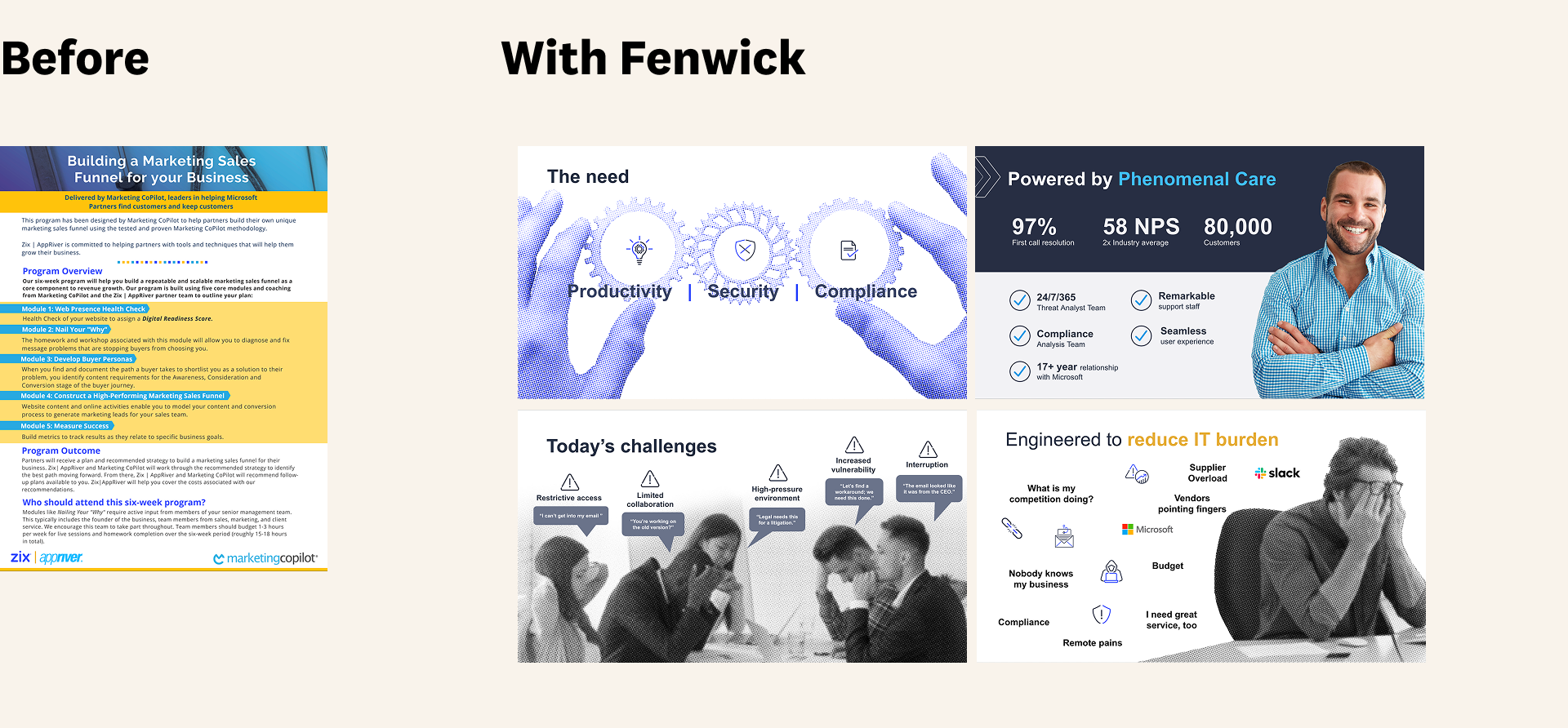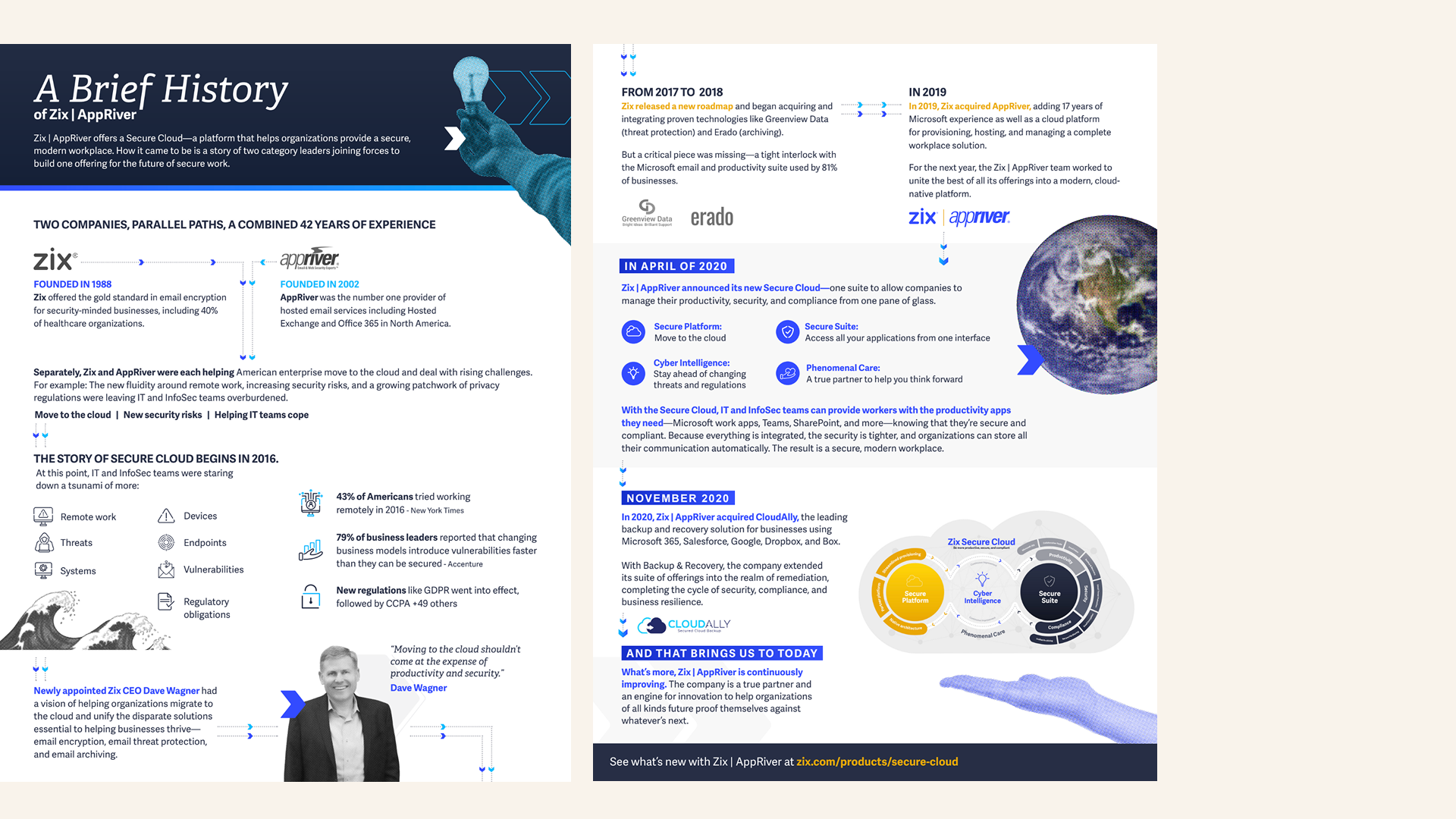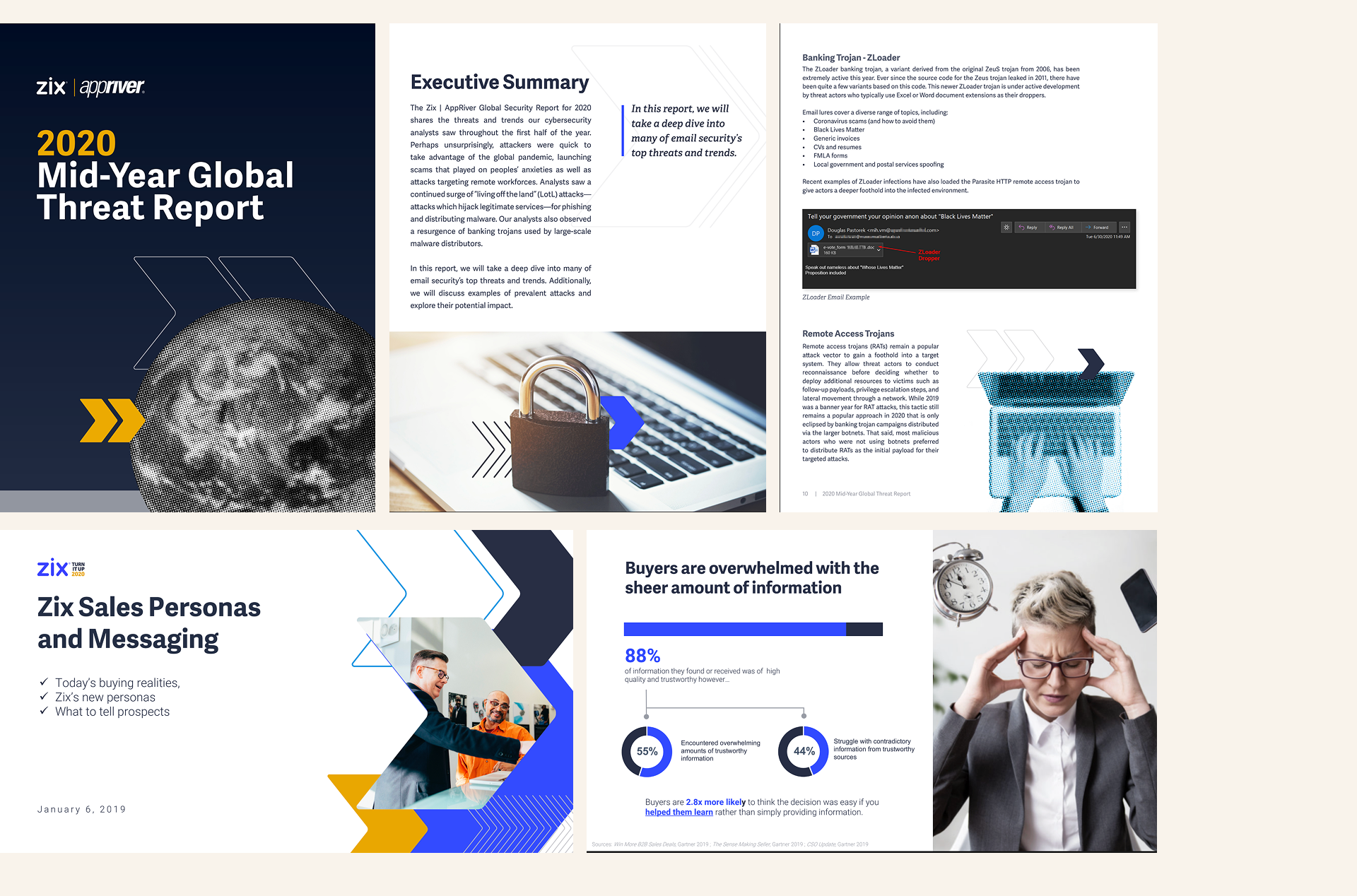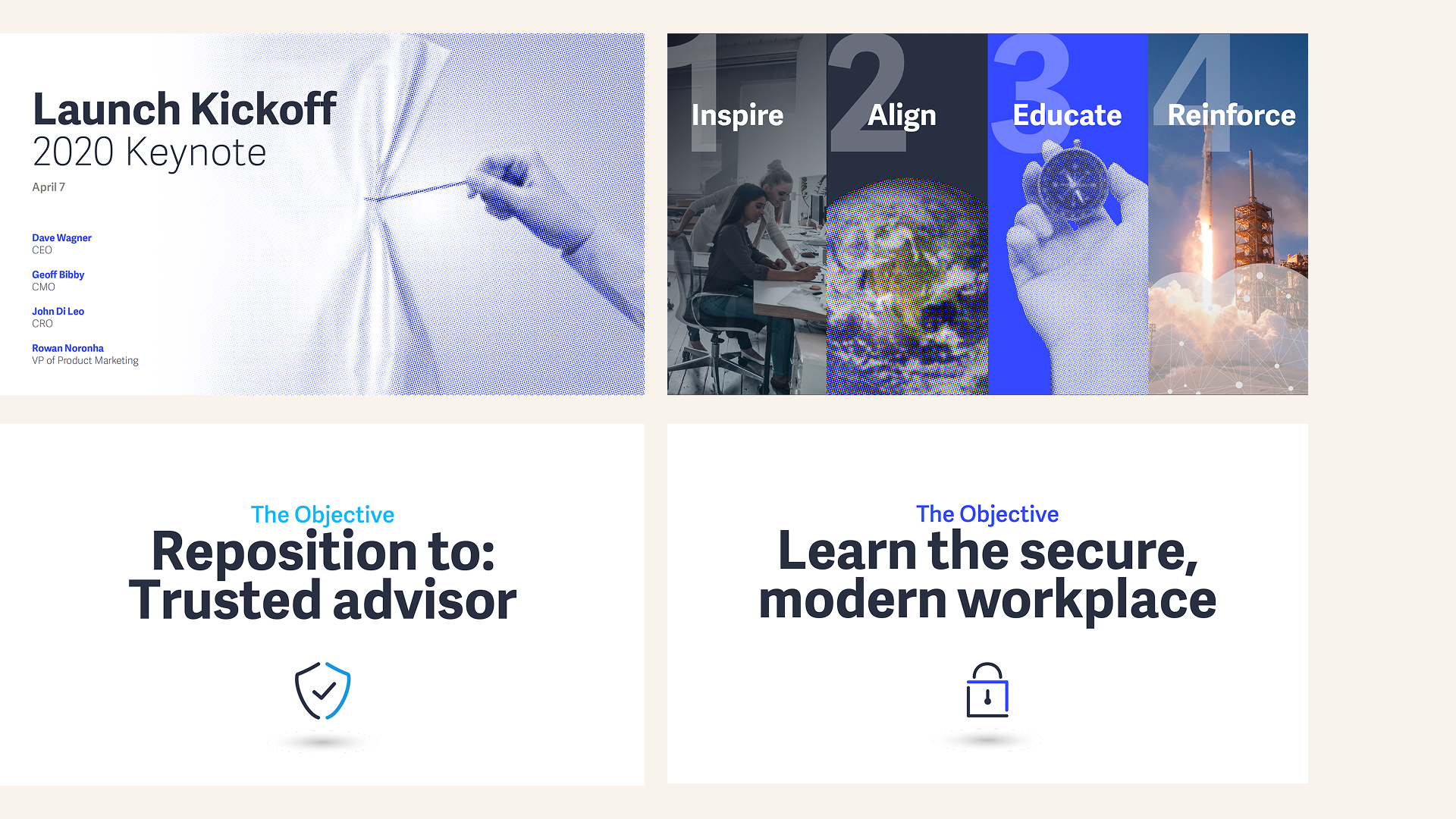
Zix needed a vision and total writing x design support
When Zix and AppRiver merged, they hired a head of product marketing to sort out the combined message. Zix was one of the largest cybersecurity softwares in the U.S. AppRiver was the number one reseller of Microsoft 365 in the U.S. Both sold to small businesses. But the overlap wasn’t clear to employees or customers—yet.
Leadership had big plans to turn these, and several other recent acquisitions, into a platform. They also knew the challenges: Two sets of somewhat competitive products. Two sales teams. Two even larger partnerships teams. Mergers like this can and do fail. So Zix called upon Fenwick for messaging strategy and to set a higher quality bar for writing and design. The work was successful and after one year, the combined entity, Zix, was acquired by OpenText.
“Chris and Clarissa were our content team. There's just no way we could have done this without them."

Geoff Bibby
RESULTS
1 year
1,500+
257 meetings
$25M

Shouting messages across a cultural chasm
The Zix and AppRiver teams were, together, about 500 people, and both companies walked happily into the merger with goodwill and high expectations. Nevertheless, the two teams were from different places. Zix was based in Lowell, Massachusetts, and commuted part of the year with tire chains. AppRiver was founded in the self-explanatorily picturesque Gulf Breeze, Florida.
On top of that, there was a great deal of inherent complication—and one might say, incompatibility:
- Zix had a large direct sales team and a small partnerships team
- AppRiver had a large partnerships team and small direct sales team
- One sold to medium-sized businesses, the other, small businesses
- The two product offerings partially overlapped—both offered email security
- They had entirely different CRMs and marketing systems
Further, “cybersecurity” really isn’t a priority to most small and medium businesses until after a disaster, when it’s too late. On the Microsoft 365 side, Microsoft was busy sunsetting its on-premise applications and kept changing the product names and pricing. And as if there weren’t enough already, enabling reseller partners is forever a challenge—many of the IT solutions providers AppRiver had in its network were inundated with offers to resell for competitors, at higher rates.
How would all the products fit together? How would the joint demand teams merge lists and run campaigns? Who would train the salespeople, and how would they prevent attrition during the transition? And, complicating it all, executives needed this transition to happen within one year because they had big plans for the combined company.
All this, and they didn’t have an internal content team save for two video producers.
Zix’ new head of product marketing hired Fenwick to act on their new “imperative” to unite the companies in story and message, and to write and design anything necessary to help the joint companies sell.

The approach: Strategy and production, both at once
Fenwick set about studying the facts with a ceaseless series of interviews. Why did small businesses want to buy Microsoft over Google Suite? What made Zix a better product than competitors Proofpoint and Sophos? Where salespeople were selling larger contact sizes, what were they doing differently?
Fenwick went onsite several times both to Lowell and Gulf Breeze to meet with the sales managers and marketers to understand, firsthand, the teams’ objections, challenges, fears, and doubts. We learned that both sales teams had been neglecting their respective narratives and just pushing features. They both had a habit of “taking deals off the table” by selling just one product for the minimum term. But then there wasn’t enough cross-sell or upsell follow-through.
When we talked to customers, they worried about the merger. They also didn’t really know the full breath of what either company offered—many AppRiver customers didn’t know they offered backup storage.
As far as sales systems went, there were some blocks we just couldn’t address. Both partnerships teams were operating out of homegrown portals that, though clunky, their partners were accustomed to.
But there was also hope, too and both companies had strengths. Zix ran a cyber command center in two locations and monitored new bugs, threats, a state actors in-real time, and when writing, we could report on that information. Meanwhile, AppRiver had the attention of Microsoft and could ask favors and request grants to run joint campaigns.

Then there was the other motion: Creating content to support our insatiable internal customers. This was the early pandemic so fears were high, and we didn’t want to accentuate them. But at the same time, the dangers were real. Cybercrime rose sharply during this time as companies went remote and manufacturers and law firms, real novices to the internet, had few defenses.
We wrote stories about local city governments getting hit with ransomware and paying the ransom only to learn that their computers couldn’t be unlocked. The hackers hadn’t bothered to build a key. And we wrote about small businesses and trucking companies forced to rapidly digitize operations and keep customer information safe.
From Fenwick’s desk flew ebooks and articles and guides and earnings call statements for the CEO. We designed office posters and email nurtures and acquisition announcements and quizzes.
Fenwick acted as a fully outsourced content strategy and production team, creating:
- Earnings call scripts for the CEO
- A new icon library
- Dozens of ebooks
- Many dozens of articles
- Case studies
- Email nurtures
- Sales decks
- Digital and social ads
- Event signage and booths
- Interactive microsites
- A sales kickoff deck and vision for the CMO
We poured all the pains we were hearing on calls and messaging coming out of the product marketing team into downloadable PDF guides and built ad and email campaigns around them. The first one of these alone generated 257 meetings, and it continued on like that.
We took all we learned and met with the CMO and head of sales and others to hammer out a plan for a unified message for the product portfolio, which the CMO then presented at the next year’s sales kickoff.

The message: Unified security cloud
It took a lot of testing and help from the PMM team but we landed on a graphic that reliably helped buyers understand that the new combined company was a platform with a vision that competitors lacked; it was a whole secure cloud—not just spam protection here, and Outlook there.

It’s been years so the numbers escape us but this was the turning point in the merger. We held training and incorporated feedback from sales and oversaw a period where joint campaigns started driving real revenue. Average contract values began to inch up. Some salespeople left but others joined who didn’t have the prior habits, and felt that the unified security cloud story gave them something to tell business owners that wasn’t just, “You’re in danger, let us save you.”
The result was one part of a many-part effort that helped the executives succeed in telling a strong growth story to the public markets, and thereafter Zix was acquired by OpenText.


